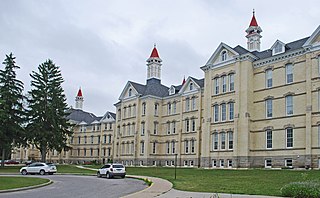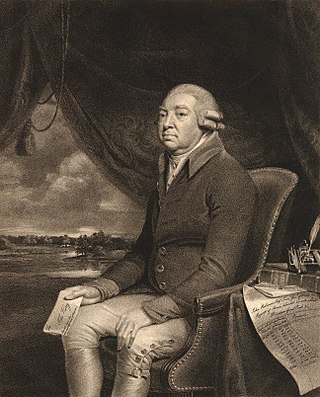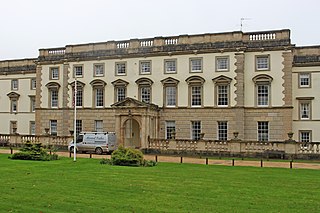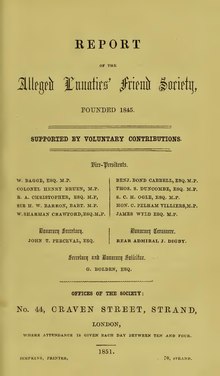
Psychiatric hospitals, also known as mental health hospitals or behavioral health hospitals, are hospitals or wards specializing in the treatment of severe mental disorders, such as schizophrenia, bipolar disorder, eating disorders, dissociative identity disorder, major depressive disorder and many others. Psychiatric hospitals vary widely in their size and grading. Some hospitals may specialize only in short-term or outpatient therapy for low-risk patients. Others may specialize in the temporary or permanent confinement of patients who need routine assistance, treatment, or a specialized and controlled environment due to a psychiatric disorder. Patients often choose voluntary commitment, but those whom psychiatrists believe to pose significant danger to themselves or others may be subject to involuntary commitment and involuntary treatment. Psychiatric hospitals may also be called psychiatric wards/units when they are a subunit of a regular hospital.

Anthony Ashley-Cooper, 7th Earl of Shaftesbury, styled Lord Ashley from 1811 to 1851, was a British Tory politician, philanthropist, and social reformer. He was the eldest son of the 6th Earl of Shaftesbury and Lady Anne Spencer, and elder brother of Henry Ashley, MP. A social reformer who was called the "Poor Man's Earl", he campaigned for better working conditions, reform to lunacy laws, education and the limitation of child labour. He was also an early supporter of the Zionist movement and the YMCA and a leading figure in the evangelical movement in the Church of England.

Bethlem Royal Hospital, also known as St. Mary Bethlehem, Bethlehem Hospital and Bedlam, is a psychiatric hospital in Bromley, London. Its famous history has inspired several horror books, films, and TV series, most notably Bedlam, a 1946 film with Boris Karloff.

The Lunacy Act 1845 or the Lunatics Act 1845 and the County Asylums Act 1845 formed mental health law in England and Wales from 1845 to 1890. The Lunacy Act's most important provision was a change in the status of mentally ill people to patients.

Robert Gardiner Hill MD was a British surgeon specialising in the treatment of lunacy. He is normally credited with being the first superintendent of a small asylum to develop a mode of treatment in which reliance on mechanical medical restraint and coercion could be dropped altogether. In practice he reached this situation in 1838.
The Commissioners in Lunacy or Lunacy Commission were a public body established by the Lunacy Act 1845 to oversee asylums and the welfare of mentally ill people in England and Wales. It succeeded the Metropolitan Commissioners in Lunacy.
John Thomas Perceval was a British army officer who was confined in lunatic asylums for three years and spent the rest of his life campaigning for reform of the lunacy laws and for better treatment of asylum inmates. He was one of the founders of the Alleged Lunatics' Friend Society and acted as their honorary secretary for about twenty years. Perceval's two books about his experience in asylums were republished by anthropologist Gregory Bateson in 1962, and in recent years he has been hailed as a pioneer of the mental health advocacy movement.

Kew Lunatic Asylum is a decommissioned psychiatric hospital located between Princess Street and Yarra Boulevard in Kew, a suburb of Melbourne, Australia. Operational from 1871 to 1988, Kew was one of the largest asylums ever built in Australia. Later known as Willsmere, the complex of buildings were constructed between 1864 and 1872 to the design of architects G.W. Vivian and Frederick Kawerau of the Victorian Public Works Office to house the growing number of "lunatics", "inebriates", and "idiots" in the Colony of Victoria.
Richard Paternoster was an English civil servant in the East India Company, a barrister and the founder of the Alleged Lunatics' Friend Society, an organisation that exposed abuses in lunatic asylums and campaigned for the reform of the lunacy laws.

The Madhouses Act 1774 was an Act of the Parliament of Great Britain, which set out a legal framework for regulating "madhouses".

The lunatic asylum or insane asylum was an early precursor of the modern psychiatric hospital.
Joseph Mason Cox (1763–1818) was an early nineteenth century English physician whose entire professional career was devoted to care and treatment of mentally ill people. Born in Bristol, the son of John Cox, he was apprenticed to a surgeon-apothecary around 1778. In 1783, he became an apprentice to James Padmore Noble, a surgeon to the Bristol Infirmary. The next year, he began to study medicine in London, followed by studies in Edinburgh, Scotland; in Paris, France; and in Leiden, Netherlands, where he received his medical degree in 1787. His thesis was titled “De Mania.”

The Old Manor Hospital was a psychiatric hospital in Salisbury, Wiltshire, England. It was established in the early 19th century as a private licensed house called Fisherton House or Fisherton House Asylum, which became the largest private madhouse in the United Kingdom. In 1924, following a change of proprietors, it was renamed Old Manor Hospital and in 1955 it was amalgamated into the National Health Service. From 1813 to 1955 it was owned and managed by members of the same family. The Old Manor Hospital closed in 2003 and was replaced by Fountain Way, a smaller, modern, psychiatric hospital on part of the same site. In 2014 the site was acquired by Quantum Group for development as a residential estate and the conversion of the main building to a hotel.

John Robinson (1727–1802) was an English lawyer, politician and government official.

Brislington House was built as a private lunatic asylum. When it opened in 1806 it was one of the first purpose-built asylums in England. It is situated on the Bath Road in Brislington, Bristol, although parts of the grounds cross the city boundary into the parish of Keynsham in Bath and North East Somerset.

Clarissa Caldwell Lathrop was an American social reformer and autobiographer. Her prominence came from her remarkable experience, being confined and unlawfully imprisoned in the Utica Lunatic Asylum for 26 months, through a plot of a secret enemy to kill her. She eventually managed to communicate with James Bailey Silkman, a lawyer who, like herself, was confined in the same asylum under similar circumstances. He succeeded in obtaining a writ of habeas corpus, and Judge George G. Barnard of the New York Supreme Court pronounced Lathrop sane and unlawfully incarcerated.

Ticehurst House Hospital was a mental health facility. It opened in 1792 and was owned and run by five generations of members of the Newington family until 1970. In 2000, the hospital name changed from Ticehurst House Hospital to The Priory Ticehurst House when it became part of the Priory Group.
The Commissioners in Lunacy for Scotland or Lunacy Commission for Scotland were a public body established by the Lunacy (Scotland) Act 1857 to oversee asylums and the welfare of mentally ill people in Scotland.
Kensington House was an academy established by 1756 in Kensington, London, England. The school was operated by a variety of people until about 1813 or 1815. After being operated as a Catholic boarding house from 1815 to 1825, it was the site of a private asylum beginning in 1830.

Sir William Charles Hood was a British medical doctor and psychiatrist of the Victorian era who pioneered the humane treatment of the mentally ill. As Superintendent at Bethlem Royal Hospital in London he reformed and civilised the hospital's regime.














